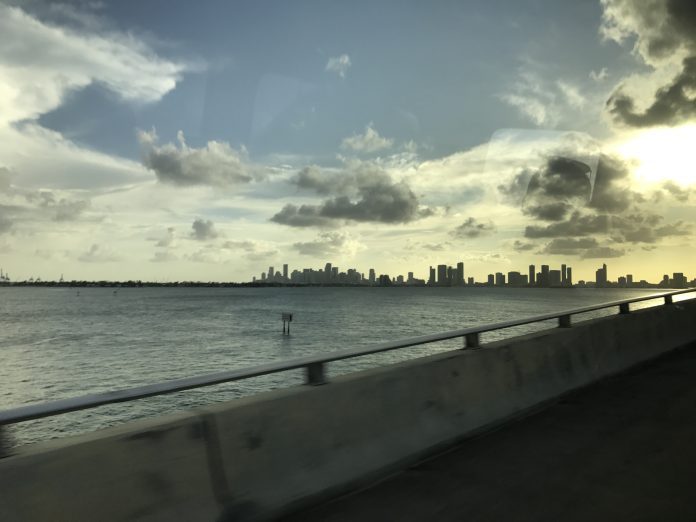The two men behind Atlantic Sapphire have no higher education – but they have undergone a truly meteoric rise to success in business.
Johan Andreassen and his long-standing business partner Bjørn-Vegard Lovik today own about 25 percent of the shares in Atlantic Sapphire, which is creating what will become the world’s largest land-based fish farm – in Homestead, Florida.
When they were in their mid-teens, the duo started fishing for wrasse, which they delivered to salmon farmers along the entire Norwegian coast.
“Heroy, Luroy. I know the area like my pocket. I can sail around there blind,” Andreassen tells Salmon Business.
Extreme cost focus
La Cruzada, Lo Mejor and Cocina Mexicana. Mariachi music can be heard from the speakers, while a Latin soap opera is showing on a television screen on the wall. Andreassen eats tacos and quesadilla in a Mexican restaurant in Florida.
“I have never actually owned a house in Norway. I’ve always rented a car and house. The house we have here is the first thing I have owned. We had an extreme cost focus. I rented my father’s house for NOK 3,500 (€375) a month and rented a Prius for NOK 2,500 (€268) a month. Bjorn-Vegard still lives in the basement of the office.”
The first step up the ladder came when the duo from Vikebukt in Romsdal sought and received a research permit for salmon back in year 2000.
They had become farmers.
Bought back
“Then we built and rented out a research vessel to the Institute of Marine Research. We got funding from Pan Fish in connection with the financing of operations. We bought it back for a fraction of the price. That was just before Fredriksen bought them up.”
Pan Fish was taken over by the banks following a brutal fall in salmon prices in 2001-2004. With its strict cost focus, the combined farmer and wrasse fisher, Villa Leppefisk, survived and used the decline to grow.
“Then we bought Misundfisk, which had three permits and a slaughterhouse.”
Now the big leap came. They raised money and established Villa Organic.
26 concessions
“Then we went to Finnmark (County in Northern Norway: Editors Note) and bought 16 concessions and nine newly issued concessions from the state. It was the “Finnmark Prize”. I think we paid NOK 4 million (€429,000) apiece. We had 26 concessions. But there were no fish there. We took over a bankruptcy estate, in effect. Just getting smolt was a problem. Even though we would grow, it took time.”
At the same time, the industry entered a boom period of strong growth. Salmon prices in 2009 and 2010 peaked from 2006 – at almost €4.8 per kilo. The time was right to cash in.
Andreassen and Lovik sold their entire holding of around 35 percent of Villa Organic in 2010. The company was then bought up and shared by the paired horses Leroy and SalMar.
The duo received nearly €10m in cash. It was a lot of money for two young men in their early 30s – without any education.
Vice City
A small percentage of the money, approximately one million dollars, they used to buy a very spacious apartment in Miami. There was a property crackdown in “Vice Cty”.
“We live in Brickall, downtown, in the financial district. There are 110 banks on that street. You have seen “Cocaine Cowboys?,” he asks before adding: “They laundered drug money there.”

“It’s an iconic building. It was on the front page of Dagens Naeringsliv (Norwegian newspaper: Editors Note); a property project of 2,000 apartments without a single being pre-sold.”
Andreassen brought his wife and three children, of eight, ten and 19 years, and moved to the US.
The property investment has paid off well. It has more than doubled in value.
Leiv Eriksson-travels
After the remarkable growth, Andreassen and Lovik chose to calm down.
“We kept a low profile after Villa. That was a high point for us.”
But they still had business plans. Together they established Atlantic Sapphire, and bought Langsand Laks, Denmark’s leading land-based salmon farmer.
“We were on our Leiv Eriksson trips, me and Bjorn-Vegard. The plan was that we should start land-based farming in the United States. We started from scratch, without knowing anything. We came into contact with the research community and institutions like Innovation Norway.
“We started in Maine, which looks like Norway. ‘This looks like a good place to do farming,’ we thought. But Maine fell quickly out of the equation. We also explored the Midwest, where we were looking for farming with fresh freshwater. We considered giving up, but hit on South Florida by chance. The apartment was not purchased for farming purposes. It was completely random. It turned out that there are totally unique geological conditions south of Orlando.”
13 states
“We spent years on site selection. When you look at what is coming up in Norway now, I do not see any comparative advantages. We wouldn’t consider starting land-based farming in Norway – nor in Chile.”
“We checked out 13 states after we started in 2010. It was only in 2013 we concluded that we should be here. And then we began to check out how bureaucracy works, what we needed in the way of permits, and so on.”
With the building site and the business concept in place, the only thing left was collecting the money. In the summer, Atlantic Sapphire raised 82 million dollars in new equity.
Norwegians
After seven years in Florida, they’re not tempted to return to Norway.
“We don’t plan to move home again. But we are Norwegians, we have a passport and could move home if we wanted. We’d move home if we got sick or went bankrupt,” he says with a laugh. “We are building a summer house in Norway. The idea is to use it for a holiday home. 350 square meters in Vikebukt in Tresfjorden.”








